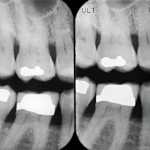
Loss of alveolar bone support is one of the consequences of periodontal disease. Bony defects are classified as suprabony (horizontal), infrabony (vertical) defects, or interradicular (furcation) and their successful regeneration is a major challenge. Bioglass is composed of silicon dioxide, sodium oxide, calcium oxide, and phosphorous pentoxide and provides a bonding interface with bone as well as with soft tissues.
The aim of this review was to assess the effect of bioactive glass on bone and periodontal regeneration.
Methods
A protocol for the review was registered on the PROSPERO database. Searches were conducted in the Medline/PubMed, Cochrane Library, Embase and DOSS (Dentistry and Oral Sciences Source) databases. Randomised controlled trials (RCTs) of bioactive glass for periodontal regeneration involving a minimum of 6 patients with at least 6-months follow up and published in English were considered. Two reviewers independently selected studies extracted data and assessed risk of bias using the Cochrane risk-of-bias tool for RCTs (RoB 2). The outcomes of interest were a decrease of probing depth (PD) and gain of clinical attachment level (CAL). A network meta-analysis (NMA) was conducted.
Results
- 20 RCTs (14-split mouth, 6 parallel) involving a total of 376 patients were included.
- 5 studies were considered to be at high risk of bias, 2 at low risk of bias and 13 having some concerns.
- The studies were published between 1997 and 2016 with follow-up periods ranging from 6 months to 4 years.
- A wide range of treatments were compared with bioglass (BG) including, platelet rich fibrin (PRF), BG/guided tissue regeneration (GTR), platelet pellet/GTR, emdogain (EMD), expanded polytetrafluoroethylene (ePTFE), demineralized freeze-dried bone allograft (DFDBA), BG+EMD and autogenous cortical bone.
- Meta-analysis focussed on 6 months follow up data. Autogenous cortical bone, bioglass and platelet rich fibrin were statistically more effective than open flap debridement (OFD) alone for probing depth. Only PRF was significant for CAL (see table below).
| PD SMD (95%CI) | CAL SMD (95%CI) | |
| Autogenous cortical bone | -1.57 (-2.90 to -0.24) * | N/A |
| Bioglass | -1.06 ( -1.72 to -0.40) * | -0.19 (-0.62 to 0.25) |
| Platelet rich fibrin | -2.89 ( -4.77 to -1.02) * | -4.13 ( -5.69 to -2.57) * |
- statistically significant
Conclusions
The authors concluded: –
Data of the present review only partially support the clinical efficacy of the usage of BG in the bone regeneration treatments for periodontal purposes. Indeed, the SMD of 0.5 to 1 in PD and CAL obtained with BG compared to OFD alone seem clinically insignificant. However, the absence of the evidence of efficacy does not mean the absence of efficacy. Some sites have reported much more significant clinical and statistical changes, whereas other sites have had smaller changes or even negative results. More good quality CTs are required to provide sound evidence on the clinical efficacy of BG.
Comments
The authors have registered a protocol for the review and searched a good range of databases. However, including only English language studies may have excluded some relevant studies. While 20 studies have been included, they have tested bioglass against a very broad range of comparator regenerative agents. The studies are also small with a majority being of spilt mouth design so there are potential issues with cross-over effects and analysis issues. While 8 of the included studies had a follow-up period of 12 months data is only presented for follow -up at six months. For probing depth the NMA ranks bioglass third after PRF and autogenous cortical bone and although a statistically significant reduction in probing depth of -1.06 ( -1.72 to -0.40) was found, it is doubtful whether this is of clinical significance. In addition, only two of the included studies were assessed as being at low risk of bias consequently the available evidence is of very low certainty so should be interpreted very cautiously.
Links
Primary Paper
Motta C, Cavagnetto D, Amoroso F, Baldi I, Mussano F. Bioactive glass for periodontal regeneration: a systematic review. BMC Oral Health. 2023 May 8;23(1):264. doi: 10.1186/s12903-023-02898-z. PMID: 37158885.
Other references
Dental Elf – 9th Feb 2022
The efficacy of periodontal regenerative therapies, more challenges with network meta-analysis
